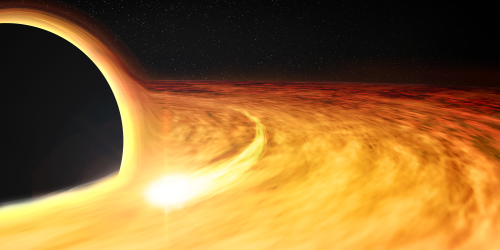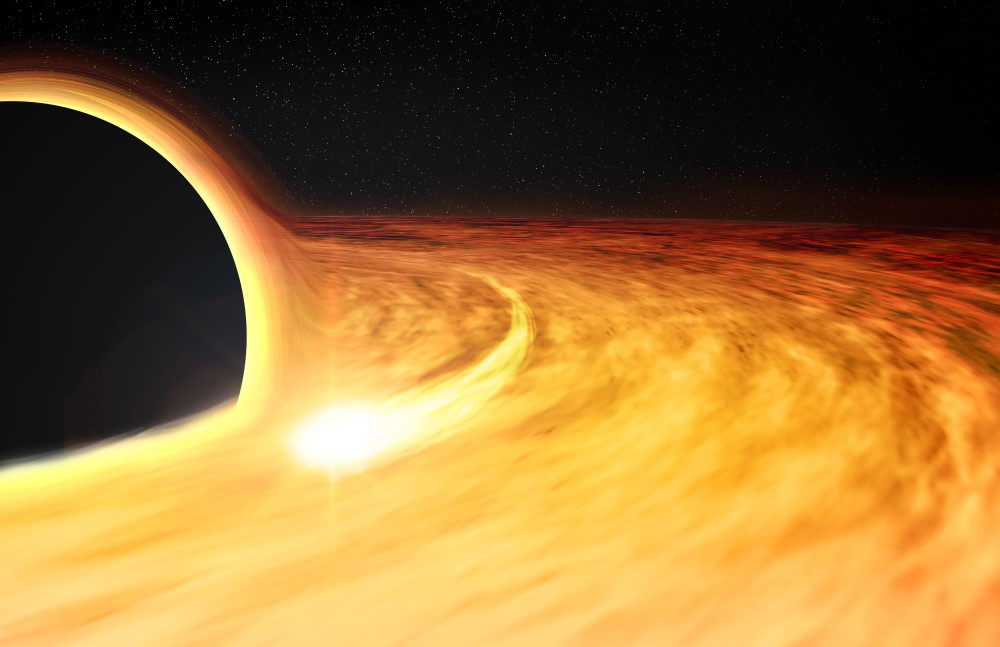Neutrinos from a Black Hole Snack
Neutrinos of extremely high energy routinely strike Earth. Physicists suspect these particles are created in cosmic processes involving black holes, but exactly which process dominates this production remains uncertain. Now astronomers report the detection of a high-energy neutrino linked directly to a tidal disruption event (TDE)—the violent shredding of a star by the intense gravity of a nearby black hole [1]. This observation is the second strong association of a high-energy neutrino with such a star-devouring event, allowing researchers to make a crude initial estimate of how many neutrinos are produced through this mechanism.
High-energy neutrinos—roughly those in the TeV energy range and above—give physicists information on some of the most violent astrophysical events in the Universe, many occurring well outside our Galaxy. Because neutrinos interact with matter so weakly, they travel unaltered over immense distances from their original production sites. Theoretical models—backed by observations—have linked them to a wide variety of potential sources, including active galactic nuclei, which are supermassive black holes that produce beams of energetic particles as they devour surrounding gas. TDEs offer another possibility, as copious neutrinos should be generated if a black hole tears apart a nearby orbiting star (see Research News: “Revolution” for Alternative Black Hole Probe). Most generation scenarios involve large black holes.
Currently, however, researchers remain unable to estimate the relative importance of these distinct processes. For example, active galactic nuclei are far more common than TDEs, but the latter could emit a very high percentage of their energy as neutrinos. As a result, “We don’t really know where the majority of high-energy cosmic neutrinos come from,” says physicist Marek Kowalski of Humboldt University in Germany. Knowing the neutrino origins would help researchers understand the extreme astrophysical events that generate some of the most energetic cosmic rays in the Universe.
Last year, Kowalski and his colleagues reported the first coincidence detection of a neutrino and a TDE [2]. The neutrino was spotted by the IceCube Neutrino Observatory—an array of detectors buried deep within the ice near the South Pole. The researchers found that the neutrino’s location in the sky corresponded to a long-lived burst of radiation that exhibited TDE signatures in archived astronomical data.
Adding to this earlier finding, Kowalski and colleagues now report finding a second TDE closely linked to a different neutrino, which was detected on 30 May 2020 by IceCube. The researchers discovered the association by using computers to sort through a database of astronomical observations collected by the Zwicky Transient Facility, California, which uses a wide-view, optical camera to scan the entire Northern Sky every two days. In their search, the team discovered an event named AT2019fdr from November 2019, which was closely associated with the most likely direction of the high-energy neutrino. Exploiting data from other telescopes, they also identified specific radiative signatures expected for a TDE.
This association is strong evidence, the researchers argue, that this neutrino was created during a years-long radiative flare released by the black-hole–star interaction. Based on a preliminary statistical analysis, they estimate that there is only a 0.034% probability that the neutrino’s direction just happened by chance to match that of the TDE. But they say that further work on localizing the neutrino direction could change this estimate.
“This is certainly a major result,” says astrophysicist Nicholas Stone of the Racah Institute of Physics in Israel. He says that the first observed association gave credence to TDEs being sources for high-energy neutrinos, but it was hard to be confident with just one event. “With a second neutrino-TDE association, we are now on much firmer footing.”
This second detection does more than just bolster confidence in the earlier detection, says team member Simeon Reusch, a Ph.D. student of Kowalski’s. It also makes possible a crude estimate of the TDE contribution to high-energy neutrino production. Comparing these two observations with the full catalog of cosmic neutrinos detected by the IceCube observatory, the researchers conclude that at least 7.8% of high-energy neutrinos must be coming from TDEs. “Because tidal disruption events are so rare, our findings indicate that they are probably extremely efficient neutrino factories,” Kowalski says.
–Mark Buchanan
Mark Buchanan is a freelance science writer who splits his time between Abergavenny, UK, and Notre Dame de Courson, France.
References
- S. Reusch et al., “Candidate tidal disruption event AT2019fdr coincident with a high-energy neutrino,” Phys. Rev. Lett. 128, 221101 (2022).
- R. Stein et al., “A tidal disruption event coincident with a high-energy neutrino,” Nat. Astron. 5, 510 (2021).





